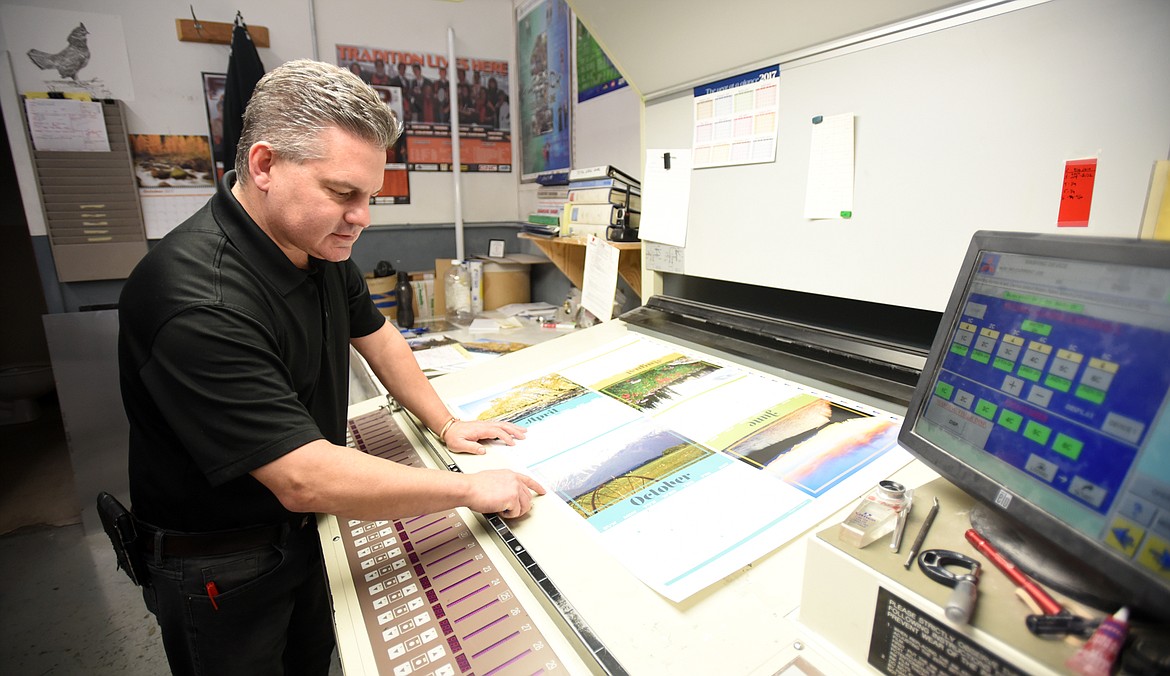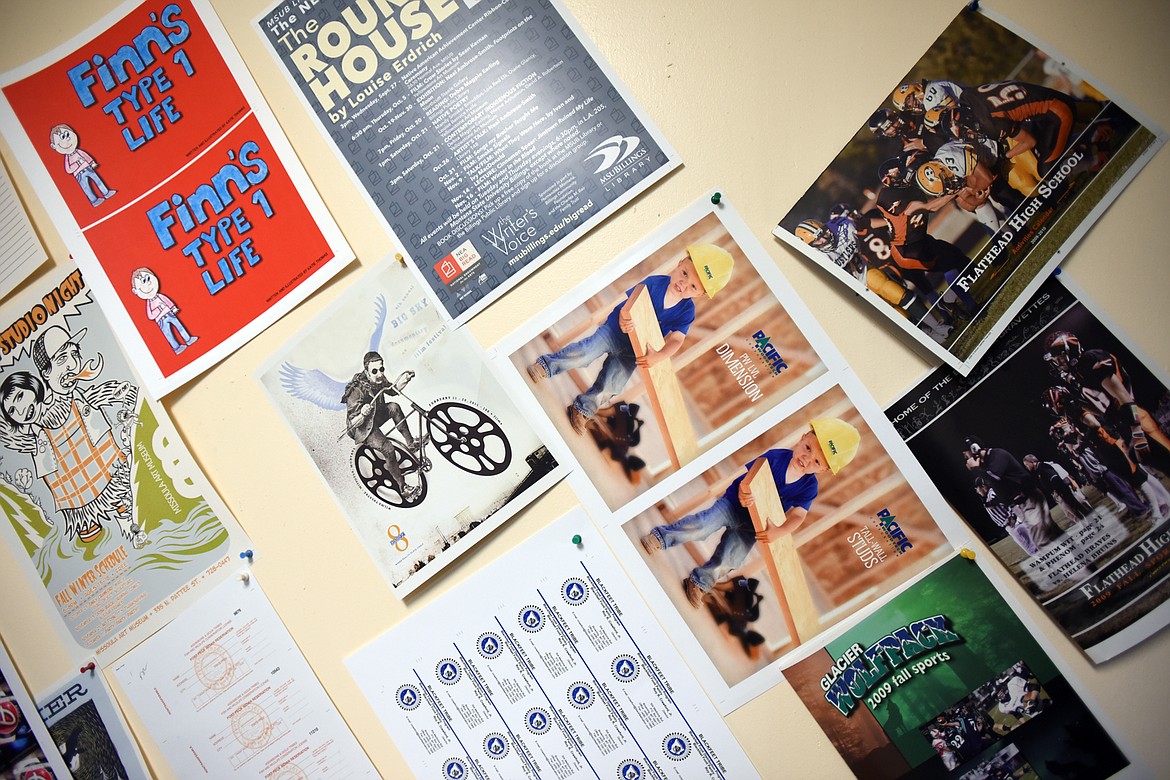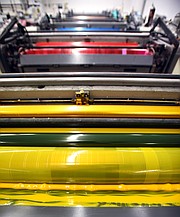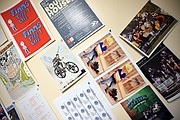Acquisition raises profile of Kalispell-based printer
Contrary to the tide of public perception, printing is not dead. One local print shop is expanding and producing more than ever.
Kalispell-based Thomas Printing recently acquired Artcraft Printers, a printing facility in Billings, and is looking to ramp up production across the state. The company also operates sales offices in Bozeman, Kalispell and Bellingham, Washington, another printing facility in Kalispell, and a storage facility with about 200,000 pounds of paper in Missoula.
The acquisition will allow the company to extend its business further into the printing needs of the oil and gas industries, said founder and owner Frank Thomas, who now runs the business with his son Chad.
They said the general perception that people are printing less is bunkum, but it doesn’t mean the printing industry is a cakewalk. They are instead threatened by an insufficient pipeline for the training of qualified workers and the same throes of globalization many small businesses are familiar with. Chad estimates that as much as $100 million of printing needs in Montana are filled by out-of-state printers, with many coming from as far afield as China.
“We have seen major, major changes in the industry,” Frank said. “In Bellingham, there is over $100 million dollars of printing that goes outside the state. In Montana there is also about $100 million.”
The father-son duo is hopeful the expansion will help them diversify the services they offer and their customer base, insuring they will continue to operate for many years to come.
“We are the most high-tech printing plant in the state of Montana,” Frank said. “We have customers all over the United States.”
Frank Thomas got his start as a “printer’s devil” in 1952 when he was just 15 years old. He melted lead, sorted paper and washed the presses. From there he obtained an apprenticeship, and within 10 years he had founded Thomas Printing in Kalispell.
The business initially was housed on First Avenue East in the ground floor of the building where KOFI radio is currently located. Thomas Printing has since moved to an expanded printing facility and office several blocks away on Sixth Avenue West.
For the last 25 years, Frank has been running the shop with the help of his son Chad, who went through junior high and high school working in the facility before he left for business school at Montana State University and got a print management and sciences degree from the Rochester Institute of Technology.
“Business wasn’t a real challenge. The printing program at RIT was more of a challenge and I was more focused on that, for sure,” Chad said. “I just think the constant change keeps you on your feet all the time. It’s always changing from day to day, from technology to technology.”
Employment at the Kalispell printing facility peaked in the early 1980s with about 28 employees, Chad said. The industry did go through a significant downtown over the ensuing decades as digital media gained prevalence and people printed less, but it forced the company to diversify and much of that demand has since returned.
“We are expanding; we have to buy more print shops in order to be able to provide what the local customers in Montana want. We have to remain competitive,” Frank said. “You get bigger, and you have to do more things. We do all kinds of different printing because we have to service the customer.”
Frank likens his company’s decision to diversify and offer new services to a similar vertical integration that has taken place in the fishing industry. It used to be that fishing boats caught fish out at sea, then brought them to port to be processed and packaged, which often happened in separate facilities by separate pools of workers.
Now, much of that work is often done on newer, gigantic ships built to accommodate all the processing and packaging before the ship ever returns to port. It cuts companies that occupied those niches out of the market, and leaves the ones left with a bigger share in production responsibility.
With the acquisition of Artcraft Printers, the company is back to its historic maximum level of employment, but the workers are split between the facilities in Billings and Kalispell. Advances in technology have cut the numbers of human hands needed in the printing process, but production per employee is also at a record high.
“In pre-press, what used to take four film strippers, one guy can do now,” Chad said. “That’s a huge, huge production gain.”
Over the past half century in the printing industry, Frank said the only way to survive is to remain nimble. These days, the quick adoption of technology and growth are both necessary to avoid getting crowded out and outbid by larger national and international printers.
“The smaller one-man operations have sort of fizzled and gone away,” Frank said.
The consolidation of printing businesses has caused another problem, one that looms large for the Thomases as they try to man their new facility with qualified workers.
Apprenticeship programs have essentially dried up and the pipeline for young people to become trained in printing is insufficient. There is still ample demand for experienced printers, but very little opportunity for people with no experience to break into the field.
“A journeyman printer is a printer that can go from town to town and ... would always have a job wherever he wanted to go,” Frank said. “That’s still the case today more than ever, but there are no apprenticeship programs.”
Frank estimates it would take the company about four years to train someone they took off the street with no printing experience to the point where they knew the business well. About 90 percent of their current employees had experience from other printers or trade schools on their resume. In any industry it is expensive to gain new talent, but that is exacerbated when most potential workers lack any educational training whatsoever.
Frank said that in his experience, people they do hire without prior printing experience are overwhelmed by the amount of training and hard work the job requires. As technology has advanced, the general public’s perception of what it takes to work in a print shop has lagged behind.
“The kids these days don’t want to get ink on their fingers, but they don’t realize that we don’t have to get ink on our fingers anymore with the technology we have,” Frank said.
Despite the trials ahead, Chad and Frank are optimistic about the future of their company. They declined to disclose what they paid to acquire the Billings plant, citing a confidentiality agreement, but they are confident it was based on sound economic reasoning and will pay off. What started many years ago as a very small business has done what it took to survive.
“The giant oak is just a little nut that held its ground,” Frank said. “It’s been a long road. I’ve been fighting this goddamn game for 80 years, so pretty soon here we’re going to make it work.”
Reporter Peregrine Frissell may be reached at (406) 758-4438 or pfrissell@dailyinterlake.com.










